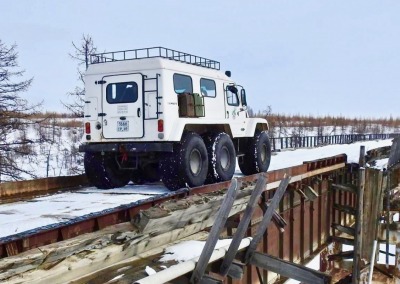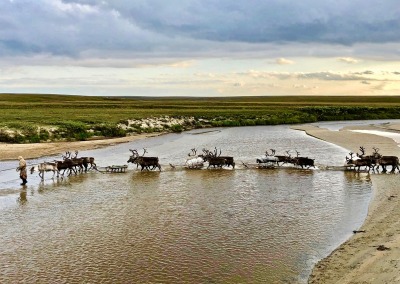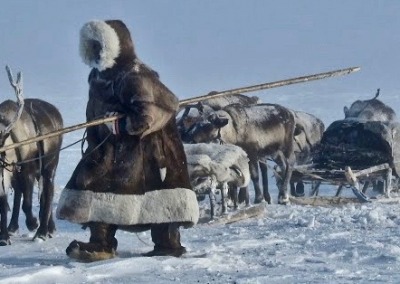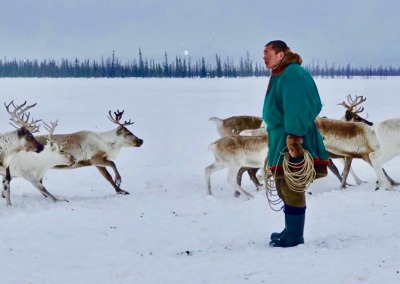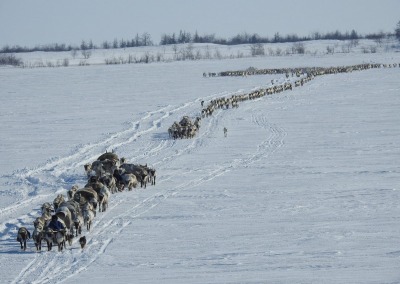Nenets language
Nenets is one of five surviving samoyedic languages, which are a subdivision of the Uralic language family. The five samoyedic languages are Tundra Nenets, Forest Nenets, Enets, Nganasan and Selkup. Tundra Nenets and Forest Nenets are very similar and are sometimes considered to be dialects rather than languages. There are fourteen different dialects of Tundra Nenets.
All the nomads from Yar-Sale, Seyakha, the Polar Ural Mountains and the Salekhard area speak Tundra Nenets, although the dialect of those in the mountains differs from those on the Yamal Peninsula (Yar-Sale and Seyakha). The Forest Nenets live slightly to the east of Salekhard in Nadym District. This is also the area where the Yar-Sale Nenets spend winter at the southernmost extent of their great migration routes. As a result, many Yar-Sale Tundra Nenets have wives from the Forest Nenets.
There are two main misconceptions repeated again and again by film crews and journalists who visit Yamal:
- That Nenets is a “dialect” of Russian. This is of course not true. Historically the Nenets migrated to Yamal from the Altai-Sayan region to the north of Mongolia and mixed with an aboriginal Arctic people that already lived there. The Russians, on the other hand, arrived from eastern Europe. Russians traded with Nenets from the 10th Century onwards but Russians never settled on Yamal until the 16th Century. So there is, and can be, no connection between the two languages. You would never say that the Native American languages are dialects of English just because English people took over America.
- That the language is called “Nenet”. This is completely incorrect. Nevertheless, it is repeated again and again by journalists and film crews who call the people “Nenet” as well. The singular form is Nenets with an “s”, and the plural in English is usually “Nenets” with an “s” too. To be 100% correct one should use “Nentsy” as the plural, as anthropological literature does, but this is often passed over in English. English-speakers naturally want to say “Nenet”, as it feels odd to use a word ending in “s” in the singular. However, there is no English or Russian word “Nenet” and it should not be used in any writing or films.
There are, these days, a few settled Nenets who do not know the Nenets language. This is quite rare though, and is usually only true for those Nenets whose parents left the nomadic way of life before they were born. They thus grew up in a village among Russians and did not have the opportunity to learn the language.
Without exception, all nomads speak Nenets as their first language. Children grow up speaking only Nenets with their families. At age seven they are sent away to boarding school in the nearest village and begin learning Russian language. They spend term time in the village and
return to migrate with their parents during school holidays. By age 14 or 15 most are fluent in both Nenets and Russian.
There are a few adult Nenets who preferred reindeer herding to school and left school early to return to the tundra. Some of these people do not speak 100% fluent Russian. In addition, there are some older people (usually age 70 and above) who were born before the time of compulsory education for all and who thus do not speak Russian. With these exceptions, a knowledge of Russian language is sufficient to communicate fluently with most Nenets people.
Amongst themselves they always speak Nenets, but when addressing Russians or foreigners they will always switch into Russian. When in a chum, most families out of politeness will talk to their guests a lot and thus will use Russian more than usual.
One time when a lack of knowledge of the Nenets language can be frustrating is when a large group of men gather together to discuss plans for migrations or lassoing reindeer. This is done exclusively in the Nenets language. The reasons for this are obvious: their language has grown around, and is therefore largely based on, a culture of reindeer herding. They have far more words for different reindeer types than the Russian language does. In addition, there are reindeer herding concepts that can be quickly explained in Nenets but are almost impossible in Russian, due to the nature and history of the language.
Thus, speaking in Nenets, everyone is able to form better plans than they would in Russian. If something goes wrong when they start lassoing, they can shout in Nenets to someone on the other side of the camp and he will immediately understand what needs doing, or which reindeer they are talking about.
The preservation of their language, as well as all other aspects of their culture, thus makes the Nenets better, more successful reindeer herders than any other Arctic nomads. It is also one of the reasons why they have the biggest reindeer herds and are the wealthiest of all reindeer herders. Reindeer herding peoples who have not preserved their own language and culture are invariably far poorer than the Nenets.
If you are interested in studying the Nenets language, any of the areas we offer tours in will be suitable, as all nomads in all areas speak Nenets as a first language. A few words in the Polar Ural Mountains and Salekhard area dialect have been more influenced by Russian than the Yar-Sale and Seyakha dialect, but not to a great extent.
Our guides all speak fluent Russian and English, with a small amount of everyday Nenets too. However, if you are very serious about studying the language, you might want a direct Nenets to English translator. Although there are none on Yamal itself, there are Nenets academics and professors in other countries who can be hired for these sorts of projects, albeit at a very high fee.
Nenets is one of five surviving samoyedic languages, which are a subdivision of the Uralic language family. The five samoyedic languages are Tundra Nenets, Forest Nenets, Enets, Nganasan and Selkup. Tundra Nenets and Forest Nenets are very similar and are sometimes considered to be dialects rather than languages. There are fourteen different dialects of Tundra Nenets.
All the nomads from Yar-Sale, Seyakha, the Polar Ural Mountains and the Salekhard area speak Tundra Nenets, although the dialect of those in the mountains differs from those on the Yamal Peninsula (Yar-Sale and Seyakha). The Forest Nenets live slightly to the east of Salekhard in Nadym District. This is also the area where the Yar-Sale Nenets spend winter at the southernmost extent of their great migration routes. As a result, many Yar-Sale Tundra Nenets have wives from the Forest Nenets.
There are two main misconceptions repeated again and again by film crews and journalists who visit Yamal:
- That Nenets is a “dialect” of Russian. This is of course not true. Historically the Nenets migrated to Yamal from the Altai-Sayan region to the north of Mongolia and mixed with an aboriginal Arctic people that already lived there. The Russians, on the other hand, arrived from eastern Europe. Russians traded with Nenets from the 10th Century onwards but Russians never settled on Yamal until the 16th Century. So there is, and can be, no connection between the two languages. You would never say that the Native American languages are dialects of English just because English people took over America.
- That the language is called “Nenet”. This is completely incorrect. Nevertheless, it is repeated again and again by journalists and film crews who call the people “Nenet” as well. The singular form is Nenets with an “s”, and the plural in English is usually “Nenets” with an “s” too. To be 100% correct one should use “Nentsy” as the plural, as anthropological literature does, but this is often passed over in English. English-speakers naturally want to say “Nenet”, as it feels odd to use a word ending in “s” in the singular. However, there is no English or Russian word “Nenet” and it should not be used in any writing or films.
There are, these days, a few settled Nenets who do not know the Nenets language. This is quite rare though, and is usually only true for those Nenets whose parents left the nomadic way of life before they were born. They thus grew up in a village among Russians and did not have the opportunity to learn the language.
Without exception, all nomads speak Nenets as their first language. Children grow up speaking only Nenets with their families. At age seven they are sent away to boarding school in the nearest village and begin learning Russian language. They spend term time in the village and return to migrate with their parents during school holidays. By age 14 or 15 most are fluent in both Nenets and Russian.
There are a few adult Nenets who preferred reindeer herding to school and left school early to return to the tundra. Some of these people do not speak 100% fluent Russian. In addition, there are some older people (usually age 70 and above) who were born before the time of compulsory education for all and who thus do not speak Russian. With these exceptions, a knowledge of Russian language is sufficient to communicate fluently with most Nenets people.
Amongst themselves they always speak Nenets, but when addressing Russians or foreigners they will always switch into Russian. When in a chum most families out of politeness will talk to their guests a lot and thus will use Russian more than usual.
One time when a lack of knowledge of the Nenets language can be frustrating is when a large group of men gather together to discuss plans for migrations or lassoing reindeer. This is done exclusively in the Nenets language. The reasons for this are obvious: their language has grown around, and is therefore largely based on, a culture of reindeer herding. They have far more words for different reindeer types than the Russian language does. In addition, there are reindeer herding concepts that can be quickly explained in Nenets but are almost impossible in Russian, due to the nature and history of the language.
Thus, speaking in Nenets, everyone is able to form better plans than they would in Russian. If something goes wrong when they are lassoing, they can shout in Nenets to someone on the other side of the camp and he will immediately understand what needs doing, or which reindeer they are talking about.
The preservation of their language, as well as all other aspects of their culture, thus makes the Nenets better, more successful reindeer herders than any other Arctic nomads. It is also one of the reasons why they have the biggest reindeer herds and are the wealthiest of all reindeer herders. Reindeer herding peoples who have not preserved their own language and culture are invariably far poorer than the Nenets.
If you are interested in studying the Nenets language, any of the areas we offer tours in will be suitable, as all nomads in all areas speak Nenets as a first language. A few words in the Polar Ural Mountains and Salekhard area dialect have been more influenced by Russian than the Yar-Sale and Seyakha dialect, but not to a great extent.
Our guides all speak fluent Russian and English, with a small amount of everyday Nenets too. However, if you are very serious about studying the language, you might want a direct Nenets to English translator. Although there are none on Yamal itself, there are Nenets academics and professors in other countries who can be hired for these sorts of projects, albeit at a very high fee.

